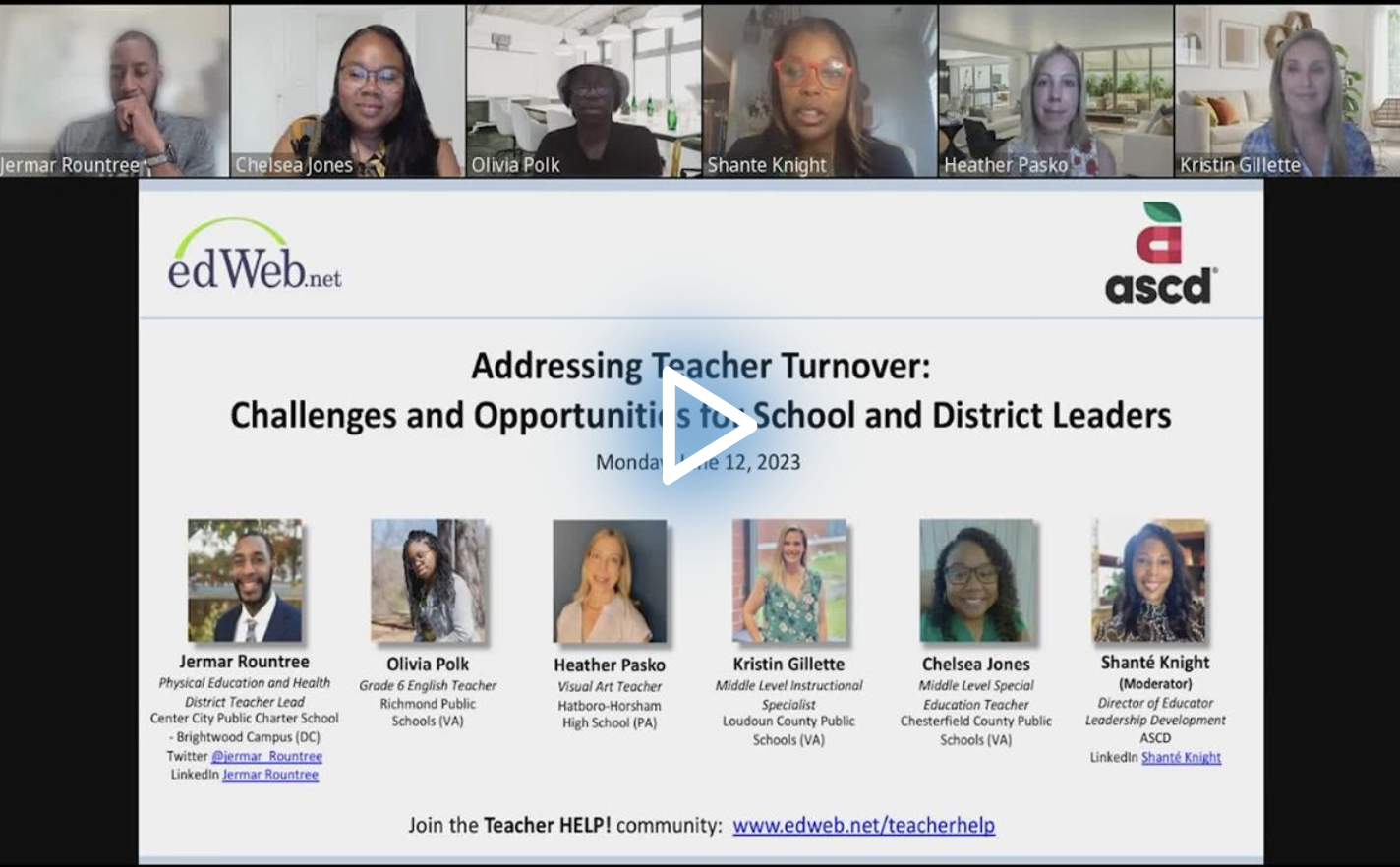Stemming Teacher Attrition: What Ed Leaders Can Do
Watch the Recording Listen to the Podcast
Across the country, there are 36,000 teacher vacancies. That may not seem like a lot, given the over four million teachers in the U.S., but suppose you multiply the vacancies by the number of students in each classroom (an average of 25) where a teacher is unavailable. In that case, you can fathom the significant effect on learning and instruction.
Teacher loss profoundly changes a school’s climate and culture, eroding a cohesive environment and relationship building, and demands the use of resources for teacher replacement rather than educational enrichment.
There is a way to stem the impact. Creative, forward-thinking leaders can develop solutions for keeping—and recruiting—teachers, explained educators in the edLeader Panel “Addressing Teacher Turnover: Challenges and Opportunities for School and District Leaders.”
Teacher Attrition: Causes and Consequences
Schools are losing teachers at concerning levels, threatening educational infrastructures. New teacher recruitment is challenging. The result? Adverse effects on student growth and achievement.
Why are so many teachers leaving the profession? The top reasons: myriad non-instructional demands, a lack of administrative support, low wages, the work-life balance struggle, student disrespect, and excessive lesson planning. Such conditions are propelling an exodus.
People with education degrees have more options in a changing job market. For example, education companies that bring products to schools are looking to education majors or teachers to support their efforts. Or teachers can move from school to school, seeking the best fit in districts with greater retention-focused opportunities.
What School Leaders Can Do
Education leaders often need help to shape retention strategies that protect the existing teaching workforce. Beginning with short-term solutions is the first step, which also jump-starts conversations about large-scale industry changes and innovations that might improve the face of teaching.
The panelists highlighted how leaders could increase teacher satisfaction and growth to sustain their current workforce.
1. Give Back Time
Teachers want to use their time in the best way possible, not only for planning but to attend to their well-being. With packed schedules and non-instructional duties, they don’t have the time and space to do either. What leaders can do on this front is:
- Allow teachers to use break time for personal needs rather than lesson planning
- Redesign the master schedule to balance students’ instructional needs with essential teacher collaboration
- Provide unencumbered time to enable teachers to plan during the day rather than work unpaid beyond school hours
2. Offer Meaningful Professional Development
Teachers want more than standard PD, which they often find repetitive and irrelevant. They seek meaningful and purposeful training that moves beyond hard skills (like how to write a lesson plan) to learn how to navigate challenging circumstances (a child having a breakdown) or bring them up to speed on topics like social-emotional learning and basic building and classroom safety.
Teachers seek readily accessible PD opportunities. They don’t want to teach themselves or pay out of pocket. PD piled on at the start of the school year (a hectic time) is too much to handle; offering training throughout the year is more practical.
Differentiated training—specific to grade levels and areas of expertise (such as special education)—is preferred over one-size-fits-all offerings. And they like a heterogenous mix of educators (i.e., veteran and new teachers) in training programs, allowing educators to learn from each other and be pushed to new places.
The best way to figure out what teachers want? Ask them what they need to succeed in the classroom. Include them in PD decision making to ensure that training correlates directly with student success.
3. Enhance School Climate and Culture
Students, teachers, and parents desire an inviting school environment where their voices are heard, solid relationships are formed, and contributions are appreciated. Approaches to climate and culture enhancement could involve:
- Maintaining transparent communication about decision making, allowing for open dialogue on issues affecting the entire school community
- Administering open-ended surveys to school community members to generate desired results related to a specific issue or proposed solution
- Ensuring feedback is productive and that everyone is open to feedback
- Promoting teamwork that leads to improvement and growth
- Formulating and modeling visibly healthy adult-to-adult relationships that trickle into the classroom, leading to positive student attitudes
- Affirming and valuing teacher talent by spending random time in the classroom (outside of the standard observation) to experience student success resulting from effective instruction
4. Establish High-Functioning Teams
Teachers should be members of executive teams that guide policies and procedures. Leaders should consider selecting educators who can effectively ideate and contribute to decision making (maybe teachers who excel in the classroom and outside of school can be district leaders or lead PD offerings, for example).
5. Provide Financial Perks
Teaching may not be lucrative; most teachers did not get into the profession for the pay. But tuition reimbursement, childcare, and sick and mental health leave are financially beneficial offerings teachers appreciate.
Envisioning a Dream School
What does a dream school look like? For the panelists, the blue-sky vision includes all the elements noted earlier, along with the following:
- Cohesive partnerships between the school and parents, who participate in critical conversations, share their ideas, and ultimately have a place in the school system (sitting on committees, participating in PD, etc.) to support what teachers do in the classroom
- Unlimited technology usage that enables teachers to teach at their best
- Passion-based learning to stimulate learner joy, engagement, and achievement
- Connections with community businesses and industry to make a difference in students’ lives through career exposure and service opportunities, and allow teachers to step out of the classroom to upskill or re-energize instruction by connecting what they teach to the real world
Learn more about this edWeb broadcast, “Addressing Teacher Turnover: Challenges and Opportunities for School and District Leaders,” sponsored by ASCD.
Watch the Recording Listen to the Podcast
Join the Community
Teacher HELP! is a free professional learning community that helps teachers get advice, support, and share experiences about teaching.

Blog post by Michele Israel, based on this edLeader Panel.





Comments are closed.